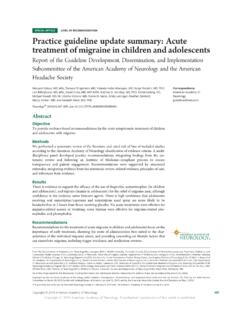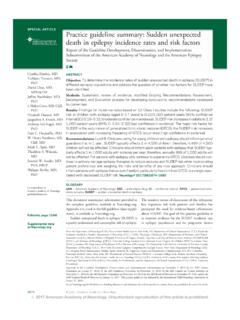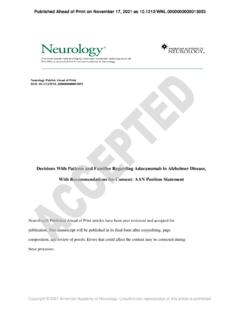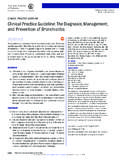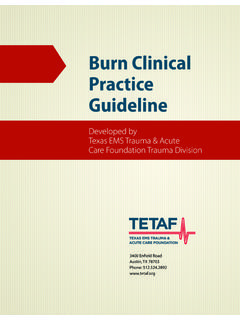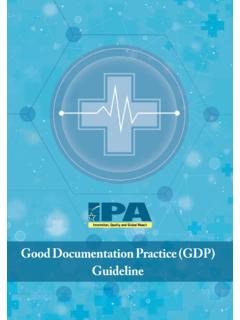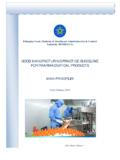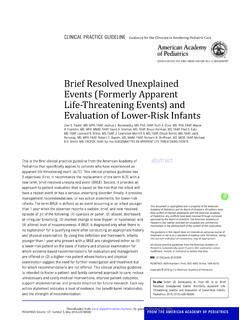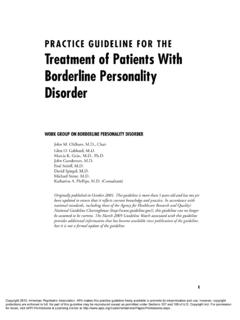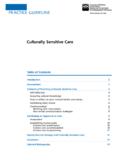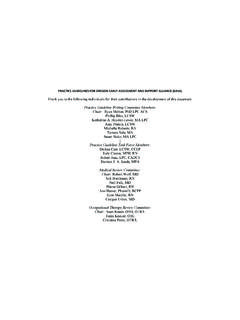Transcription of Practice guideline update recommendations summary ...
1 SPECIAL ARTICLEP ractice guideline update recommendations summary :Disorders of consciousnessReport of the guideline Development, Dissemination, and Implementation Subcommittee of theAmerican Academy of Neurology; the AmericanCongress of Rehabilitation Medicine; and theNational Institute on Disability, Independent Living, and Rehabilitation ResearchJoseph T. Giacino, PhD, Douglas I. Katz, MD, Nicholas D. Schiff, MD, John Whyte, MD, PhD, Eric J. Ashman, MD,Stephen Ashwal, MD, Richard Barbano, MD, PhD, Flora M. Hammond, MD, Steven Laureys, MD, PhD,Geoffrey Ling, MD, Risa Nakase-Richardson, PhD, Ronald T. Seel, PhD, Stuart Yablon, MD,Thomas Getchius, Gary S. Gronseth, MD, and Melissa J. Armstrong, MD, MScNeurology 2018;00:1-11. Academy update the 1995 American Academy of Neurology (AAN) Practice parameter on persistent vegetativestate and the 2002 case definition on minimally conscious state (MCS) and provide care recom-mendations for patients with prolonged disorders of consciousness (DoC).
2 MethodsRecommendations were based on systematic review evidence, related evidence, care principles, and inferencesusing a modified Delphi consensus process according to the AAN 2011 process manual, as should identify and treat confounding conditions, optimize arousal, and perform serialstandardized assessments to improve diagnosticaccuracy in adults and children with prolonged DoC(Level B). Clinicians should counsel families that for adults, MCS (vs vegetative state [VS]/unresponsive wakefulness syndrome [UWS]) and traumatic (vs nontraumatic) etiology are associatedwith more favorable outcomes (Level B). When prognosisispoor,long-term care must be discussed(Level A), acknowledging that prognosis is not universally poor (Level B). Structural MRI, SPECT,and the Coma Recovery Scale Revised can assist prognostication in adults (Level B); no tests areshown to improve prognostic accuracy in always should be assessed and treated (LevelB) and evidence supporting treatment approaches discussed (Level B).
3 Clinicians should prescribeamantadine (100 200 mg bid) for adults with traumatic VS/UWS or MCS (4 16 weeks post injury) tohasten functional recovery and reduce disability early in recovery (Level B). Family counseling con-cerning children should acknowledge that natural history of recovery, prognosis, and treatment are notestablished (Level B). Recent evidence indicates that the term chronic VS/UWS should replacepermanent VS, with duration specified (Level B). Additional recommendations are ARTICLESA rticlesComprehensive systematicreview update summary :Disorders of consciousness:Report of the GuidelineDevelopment, Dissemination,and ImplementationSubcommittee of theAmerican Academy ofNeurology; the AmericanCongress of RehabilitationMedicine; and the NationalInstitute on Disability,Independent Living, andRehabilitation ResearchPage 461 Ethical, palliative, and policyconsiderations in disorders ofconsciousnessPage 471 From the Department of Physical Medicine and Rehabilitation ( ), Spaulding Rehabilitation Hospital and Harvard Medical School; Department of Psychiatry ( ), Massachusetts GeneralHospital, Boston; Department of Neurology ( ), Boston University School of Medicine; Braintree Rehabilitation Hospital ( ), MA; Department of Neurology and Neuroscience ( ), WeillCornell Medical College, New York, NY.
4 Moss Rehabilitation Research Institute ( ), Elkins Park, PA; Bronson Neuroscience Center ( ), Bronson Methodist Hospital, Kalamazoo, MI; Departmentof Pediatrics, Division of Child Neurology ( ), Loma Linda University School of Medicine, CA; Department of Neurology ( ), University of Rochester Medical Center, NY; Indiana UniversityDepartment of Physical Medicine & Rehabilitation ( ), University of Indiana School of Medicine, Indianapolis; Coma Science Group GIGA Research and Department of Neurology ( ), SartTillman Li`ege University & University Hospital, Li`ege, Belgium; Department of Neurology ( ), Uniformed Services University of Health Sciences, Bethesda; Department of Neurology ( ),Johns Hopkins University, Baltimore, MD; James A. Haley Veterans Hospital ( ), US Department of Veterans Affairs, Tampa, FL; Crawford Research Institute ( ), Shepherd Center, Atlanta, GA;Center for Rehabilitation Science and Engineering, Department of Physical Medicine & Rehabilitation ( ), Virginia Commonwealth UniversitySchool of Medicine, Richmond; Division of PhysicalMedicine & Rehabilitation ( ), University of Mississippi School of Medicine; Brain Injury Program ( ), Methodist Rehabilitation Center, Jackson, MS; Heart Rhythm Society ( ), Washington, DC;Department of Neurology ( ), University of Kansas Medical Center, Kansas City; and Department of Neurology ( ), University of Florida College of Medicine, to for full disclosures.
5 Funding information and disclosures deemed relevant by the authors, if any, are provided at the end of research was supported through a memorandum of understanding between the American Academy of Neurology, the American Congress of Rehabilitation Medicine, and theNational Institute on Disability and Rehabilitation Research (NIDRR). In 2014, NIDRR was moved from the US Department of Education to the Administration for Community Living of theUS Department of Health and Human Services, and was renamed the National Institute on Disability, Independent Living, and Rehabilitation Research (NIDILRR). This article does notreflect the official policy or opinions of NIDILRR or HHS and does not constitute an endorsement by NIDILRR, HHS, or other components of the federal theAAN GuidelineDevelopment,Dissemination,andIm plementationSubcommitteeonOctober 21,2017; bythe AANP ractice CommitteeonApril 9,2018;bythe AmericanCongress of Rehabilitation Medicine Board of Governors on April 30, 2018; by the National Institute on Disability, Independent Living, and Rehabilitation Research Review Committee onApril 5, 2018; and by the AAN Institute Board of Directors on May 2, Practice guideline was endorsed by the American Academy of Physical Medicine and Rehabilitation on April 4, 2018; by the American College of Surgeons Committee on Trauma onJuly 3, 2018.
6 And by the Child Neurology Society on April 17, special article is published simultaneously in theArchives of Physical Medical responsible for peer review of this 2018 American Academy of Neurology. Unauthorized reproduction of this article is prohibited. Published Ahead of Print on August 8, 2018 as article presents Practice guideline recommendationsdeveloped by the American Academy of Neurology (AAN),the American Congress of Rehabilitation Medicine (ACRM),and the National Institute on Disability, Independent Living,and Rehabilitation Research (see complete guideline at ). A companion article summarizessystematic review noted, recommendations apply to individuals withprolonged disorders of consciousness (DoC) ( , 28 days).Recommendation rationales are presented; tables summarizerecommendations for adults (tables 1 3) and children(table 4).Recommendation 1 rationaleOur systematic review highlights the complexities of caring forpatients with prolonged DoC ( , 28 days) at every patients may be misdiagnosed due to confoundingneurologic deficits2or inexperience in examining patients forsubtle signs of diagnosis is impor-tant to educate families about patients level of consciousnessand function, inform prognostic counseling, and guide treat-ment decisions.
7 Knowledge gaps often lead to overestimationor underestimation of prognosis by addi-tion, patients with prolonged DoC frequently experiencesignificant medical complications that can slow recovery andinterfere with treatment view of this risk,patients are likely to have a better chance for recovery if care isprovided in a specialized setting managed by clinicians whoare knowledgeable about the risks associated with DoC andare capable of initiating timely treatment. This is supported byfindings from a large retrospective trauma registry, whichfound that cumulative mortality at 3 years postdischarge issignificantly lower for patients discharged to home or in-patient rehabilitation facilities than those discharged to skillednursing facilities, even after adjusting for forpatients with prolonged DoC may benefit from a team ofmultidisciplinary rehabilitation specialists, including neurol-ogists, psychologists, neuropsychologists, physiatrists, physi-cal therapists, occupational therapists, speech pathologists,nurses, nutritionists, internists, and social 2 rationaleThe range of physical and cognitive impairments experiencedby individuals with severe DoC complicates diagnostic accu-racy and makes it difficult to distinguish behaviors that areindicative of conscious awareness from those that are randomand nonpurposeful.
8 Interpretation of inconsistent behaviorsor simple motor responses is particularly challenging. Fluc-tuations in arousal and response to command further con-found the reliability of clinical ,8 Underlyingcentral and peripheral impairments, such as aphasia, neuro-muscular abnormalities, and sensory deficits, may also maskconscious 11 Clinician reliance on non-standardized procedures, even when the examination is per-formed by experienced clinicians,2,12,13contributes todiagnostic error, which consistently hovers around 40%. Di-agnostic error includes misdiagnosing the locked-in syndromefor vegetative state/unresponsive wakefulness syndrome(VS/UWS) and minimally conscious state (MCS).14,15Ac-curate diagnosis of the level of consciousness has implicationsfor prognosis and 2a rationaleIn view of the range of clinical challenges to accurate andreliable diagnosis of DoC, standardizing the assessment ofpatients with DoC can assist in recognizing key diagnosticfeatures that may be missed on ad hoc ,16 Thevalidity and reliability of standardized neurobehavioral as-sessment scales for diagnosis of DoC subtype have beenpreviously techniques such as in-dividualized quantitative behavioral assessment have beenuseful in distinguishing specific purposeful responses fromgeneralized, nonpurposeful, or reflexive thebasis of thesefindings, diagnostic accuracy may be enhancedby using standardized neurobehavioral assessment measuresover qualitative bedside examination alone.
9 If standardizedassessments are used, those with the highest quality of evi-dence should be employed. A systematic review performed byACRM recommended the Coma Recovery Scale Revised(CRS-R),16 Wessex Head Injury Matrix,19 Sensory ModalityAssessment and Rehabilitation Technique,20 Western Neu-roSensory Stimulation Protocol,21 Disorders of Conscious-ness Scale,22and Sensory Stimulation Assessment Measure23for use in clinical 2b rationaleWhile there is insufficient high-quality evidence to recom-mend the use of serial evaluations to improve diagnosticsensitivity and specificity, because of the inconsistency andvariability of behavioral responses that is characteristic ofSupplemental DataFull text of guideline American Academy of Neurology;ACRM= American Congress of Rehabilitation Medicine;CI= confidence interval;CRS-R= Coma Recovery Scale Revised;DoC= disorders of consciousness;DRS= Disability Rating Scale;FDG=fluorodeoxyglucose;MCS= minimally conscious state;TBI= traumatic brain injury.
10 UWS= unresponsive wakefulnesssyndrome;VS= vegetative | Volume , Number | Month 0, 2018 American Academy of Neurology. Unauthorized reproduction of this article is with prolonged DoC, reliance on a single exami-nation may contribute to greater risk of misdiagnosis. Multi-ple behavioral evaluations over time may improve diagnosticreliability and accuracy as compared with a single evaluations conducted by trained clinicians usinga standardized, validated neurobehavioral assessment in-strument have the potential to improve the reliability/validityof diagnosis. There are insufficient data to recommenda minimum duration of time for an assessment session or howoften serial examinations should be performed. The frequencyof serial standardized neurobehavioral examinations shouldbe based on clinical judgment with consideration given toreported changes in arousal and responsiveness, the removalor cessation of diagnostic confounders, and the length of timesince the last 2c/2d rationalePatients with prolonged DoC may exhibit inconsistent orreduced behavioral responsiveness because offluctuations inthe level of arousal, systemic medical problems, secondaryneurologic complications, and other adverse events ( ,medication side effects).

